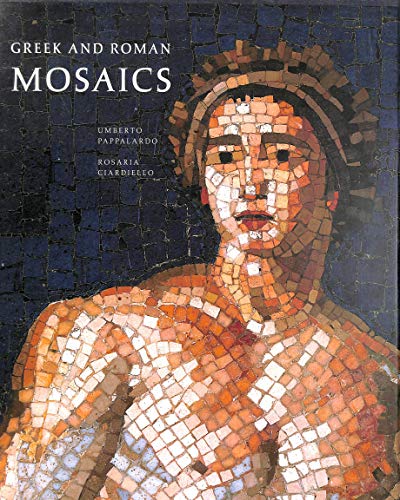Articoli correlati a Greek and Roman Mosaics

The styles and techniques of the ancient mosaicist’s art are given a concise yet authoritative exposition in the first part of this handsome volume. The second, and larger, part conducts the reader on a chronological tour of the most important centers of the art form’s development, from the Macedonian capital of Pella, whose compositions in natural pebbles set a high artistic standard for mosaics at the very beginning of their history, to the Basilica of San Vitale at Ravenna, whose wall and vault mosaics, with their glittering vision of a triumphant Christianity, mark the transition between antiquity and the Middle Ages. Special attention is given to Pompeii and its surroundings, where the eruption of Vesuvius in AD 79 preserved intact an astonishing variety of mosaics, including such ambitious figural scenes as the famous Alexander mosaic, composed of some four million miniscule tesserae, as well as characteristically Roman pavements in black and white, and the brightly colored wall mosaics of garden grottoes.
Featuring more than two hundred newly commissioned photographs, Greek and Roman Mosaics is the first survey of its subject to be illustrated in full color. It will be a necessary addition to every art lover’s library, and a worthy companion to Abbeville’s Italian Mosaics: 300 1300.
Le informazioni nella sezione "Riassunto" possono far riferimento a edizioni diverse di questo titolo.
Rosaria Ciardiello, also a classical archaeologist, received her doctorate from the University of Naples Federico II.
Luciano Pedicini, a second-generation photographer of antiquities, has contributed to numerous important publications.
Mosaic was a widespread form of decoration in the Greek and Roman world. Evidence of its popularity can be seen in the many square miles of mosaic floors that survive from Syria to Greece, from Egypt to Tunisia, from Spain to France, from Britain to Germany, and from Croatia to Italy.
In the Hellenistic age, the tyrant Hiero II of Syracuse gave King Ptolemy III of Egypt a grand ceremonial ship whose cabins were decorated with splendid mosaics depicting scenes from the Iliad, while in the Roman age, Julius Caesar brought mosaics along on his military campaigns, presumably to adorn his tent, and the emperor Caligula desired that even his luxurious vessels on Lake Nemi be covered with polychrome mosaics.
In our own time, after one of the icons of modern culture, John Lennon of the Beatles, was assassinated on the street outside his home in New York, a nearby area of Central Park was turned into a memorial known as Strawberry Fields. This memorial features a round mosaic of a stylized sun with the title of Lennon’s most famous song, “Imagine,” in the center. Its geometric pattern may have been inspired by those of Roman mosaics, such as the apse of the caldarium in the House of Menander at Pompeii. And so we find one of the most representative arts of antiquity, seemingly vanished forever, making a very striking reappearance in the contemporary world.
This example of artistic continuity is not unique. In February 1917, when a performance of the Ballets Russes, with scenery and costumes by Picasso, was staged at the Teatro di San Carlo in Naples, the artist visited Pompeii with the dancer Leonide Massine and the impresario Sergei Diaghilev. None other than Jean Cocteau, who was directing the show, took a photograph of Picasso and Massine in front of the mosaic fountain in the House of Marcus Lucretius Fronto (plate 2). In the House of the Labyrinth, Picasso had the opportunity to see a mosaic depicting the Minotaur (plate 4). The artist, who had attended the Spanish bullfights since childhood and was moreover a man of extraordinary sensibility, could not but identify with this man-bull who is betrayed to his death by his half-sister. The Minotaur leaves the cave anguished, not so much by the wounds to his body as by those inflicted on his heart. From this encounter arose one of the most celebrated themes of Picasso’s art (plate 3).
The posthumous influence of the ancient art of mosaic does not end there; many other examples could be cited. For instance, some years ago, a well-known italian musical agent and passionate archaeologist of the Near East had a copy of the central part of the famous mosaic map in Madaba, depicting the city of Jerusalem and the Dead Sea, made for the music room of his home near Verona (plate 232).
Still, beginning in the Middle Ages, the art of tessellated mosaic was largely supplanted by that of large marble inlays. The cause of this decline is difficult to determine, although it is possible that in the Roman world, where half the population was enslaved, the low cost of manpower allowed for a greater abundance of such handicrafts. Indeed, the many square miles of ancient mosaics suggest that while they were very elaborate, they must not have been very costly to make. Today, in any case, the medium no longer has the importance that it did in antiquity, and there are only sporadic revivals, such as those by Italian craftsmen in Ravenna and Piazza Armerina, intended for the luxury market.
Le informazioni nella sezione "Su questo libro" possono far riferimento a edizioni diverse di questo titolo.
- EditoreAbbeville Pr
- Data di pubblicazione2012
- ISBN 10 0789211254
- ISBN 13 9780789211255
- RilegaturaCopertina rigida
- Numero edizione1
- Numero di pagine320
- Valutazione libreria
Compra nuovo
Scopri di più su questo articolo
Spese di spedizione:
EUR 3,74
In U.S.A.
I migliori risultati di ricerca su AbeBooks
Greek and Roman Mosaics
Descrizione libro Hardcover. Condizione: new. New. Fast Shipping and good customer service. Codice articolo Holz_New_0789211254
Greek and Roman Mosaics
Descrizione libro Hardcover. Condizione: new. Buy for Great customer experience. Codice articolo GoldenDragon0789211254
Greek and Roman Mosaics
Descrizione libro Hardcover. Condizione: new. New. Codice articolo Wizard0789211254
Greek and Roman Mosaics
Descrizione libro Condizione: new. Codice articolo FrontCover0789211254
Greek and Roman Mosaics
Descrizione libro Hardcover. Condizione: new. New Copy. Customer Service Guaranteed. Codice articolo think0789211254

